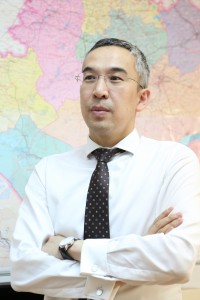ASTANA – As Kazakhstan works to diversify its economy, the development of tourism has become a national priority. Chairman of the Tourism Industry Committee of the Ministry of Industry and New Technologies Marat Igali spoke about Kazakhstan’s efforts to ramp up tourism in an exclusive interview with The Astana Times.
Which countries or regions should Kazakhstan focus on to draw tourists?
According to the Statistics Agency of Kazakhstan, the total number of foreign visitors who entered Kazakhstan in 2012 amounted to 6,163,204 people, 8.4 percent more than in 2011. Most visitors came from three neighbouring countries: Uzbekistan (37.1 percent of the total), the Kyrgyz Republic (23.6 percent) and Russia (22.2 percent).
A total of 75.9 percent of visitors come to Kazakhstan for private visits, 18.2 percent transit our country, and 5.9 percent come for business trips and vacations.
As a result of our analysis, we see that the key markets to attract tourists to Kazakhstan, besides the CIS countries, are Russia, China, the Middle East and India. It is a market of 200 million tourists: that is the number of people travelling outside their own countries in a year. … Growing tourist demand in emerging foreign markets, such as China, India, the Middle East and Russia, as well as their geographical positions, provide an opportunity to develop tourism products for these markets, which will be relatively easy to implement because of their geographical proximity to Kazakhstan. It is worth noting that every foreign tourist … according to statistics, supports at least three jobs, because tourism contains accommodation, food, entertainment, transport, et cetera.
Experts consider it necessary to work to facilitate visa and migration regimes with these countries. Practical mechanisms could be online visas and lengthening the time these visitors can stay without registering with immigration authorities from five to 15 days. According to the Ministry of Foreign Affairs, Kazakhstan will introduce a visa-free regime with 10 developed countries in the near future. Further plans are to introduce a visa-free regime for the five-month summer period for 40 countries. Along with this, the Foreign Ministry is considering introducing a simplified visa regime for group tourism.
What are the main challenges for the development of tourism in Kazakhstan? How can they be overcome?
Today, the tourism industry faces big obstacles for future development. High prices for imported goods impact hotels and restaurants, leading to the need to set higher prices. [Difficult] access to credit resources puts constraints on investment and the opportunities private entrepreneurs have to improve their businesses. Restrictions on obtaining permits for construction [and to acquire land] cause low interest from foreign and domestic investors. There are also issues regarding vocational education.
Resolutions for these issues are reflected in the Concept of Tourism Industry Development in Kazakhstan to 2020, which includes four main pillars: improving the legal framework, improving infrastructure, active marketing and cluster development with the support of significant projects. The concept contains a list of necessary changes to the regulatory framework: cancelling the visa regime for citizens of economically and politically stable countries, creating special tourist zones, creating tourist certificates, working to attract more inbound tourism, attracting investors and developing infrastructure in tourist regions.
What are some of Kazakhstan’s recent achievements in tourism?
Probably one of the latest achievements in the field of tourism is the adoption of the Concept of Tourism Industry Development in Kazakhstan to 2020 by the government of Kazakhstan on May 19. The main strategic goal of the document is to establish Kazakhstan as a globally recognised tourist destination by 2020.
The concept involves the development of five regional clusters – Astana, Almaty, East Kazakhstan, South Kazakhstan and West Kazakhstan – with Astana and Almaty seen as the centres for business tourism [and] Almaty as a centre of international mountaineering. [East Kazakhstan will focus on ecotourism, South Kazakhstan on cultural tourism, and West Kazakhstan on cultural and beach tourism.]
National projects are to be implemented, [including] Burabai in the Astana cluster, ski resorts in the Almaty cluster, Bukhtarma and Katon-Karagai in East Kazakhstan, Kenderli in West Kazakhstan. When all projects within the concept have been implemented, growth in these destinations is projected to increase by 2.3 times and the number of tourists to increase by 8 million tourists a year.
It should be noted that one working position in tourism costs 10 times less than in industry, and creates employment particularly for youth and women. By 2020, taking into account the multiplier effect, considering the implementation of all measures, it is projected that more than 200,000 new jobs will be created.
If Kazakhstan manages to attract more people to historic sites in the south, what steps will you take to protect these places from damage? Do you cooperate with any state authority on the protection of historical monuments?
The Tourism Industry Committee and other state authorities are actively cooperating to preserve historical and cultural monuments with international organisations such as the UNWTO [United Nations World Tourism Organisation] and UNESCO. In October 2013 in Almaty, the Ministry of Industry and New Technologies of Kazakhstan held an international working meeting on the Great Silk Road with the UNWTO and UNESCO. This working meeting provided a unique opportunity to discuss and promote a joint UNWTO and UNESCO project, which was announced at the Meeting of Ministers of Tourism of the Silk Road at the Berlin Tourism Exchange in March 2013. For the first time, the four Central Asian countries – Kazakhstan, Uzbekistan, Tajikistan and Kyrgyzstan – and China have joined efforts to develop a common strategy for the development of tourism to the historical and cultural heritage of the Silk Road, using a corridor approach. Special attention was paid to the overall management of facilities and planning of tourist activity along the Silk Road through the development of guidelines and strategies for the presentation and promotion of facilities based on best practices. This project uses the possibilities offered by the final stage in the serial nomination of the Silk Road as a World Heritage Site and its huge impact on the future of tourism in the region.
There are many national parks in Kazakhstan, some with very sensitive ecosystems. What is being done to protect and develop them?
Currently, there are 12 national parks and 10 nature reserves in Kazakhstan that are specially protected natural territories. Measures to further develop the tourism industry in protected areas and forests are also included in the Concept of Tourism Industry Development. The development of criteria for tourist attraction among them should be underlined, as well as tourist requirements for priority projects for long-term use and the state forest fund and ecotourism. With the sustainable use and management of sites and protected areas and the state forest fund for the implementation of tourism projects, measures to increase the liability of users who damage the environment through activities like illegal wood chopping, water pollution, damaging surface soil and other acts as well as mechanisms to promote natural resources by increasing the area of forest plantations, restoration of objects of natural reserve fund will be reviewed.
Are you aware of the movement called “Tourism is everyone’s business?” Do you cooperate with them to attract tourists to the country and to develop the regions of the country?
“Tourism is everyone’s business” was created with the support of the Tourism Industry Committee. The idea was born during one of the offline meetings of the “How to develop tourism in Kazakhstan” Facebook group. The project’s goal is to have tourism experts provide free training for the whole tourism community, including those who hope to do business in tourism. The main objective of the project is the successful development of the tourism industry in the country.
This is how the committee established feedback with the tourism community, by creating an active dialogue platform where participants discuss current issues, make recommendations, offer their ideas – many of which were incorporated into the concept – and share the latest news about tourism in Kazakhstan and the world. Within the framework of the [concept] it is assumed that active work will be done to attract tourists through online marketing activities, including activities on leading online platforms like Google Earth and Trip Advisor and with the help of social networks such as Facebook and Twitter.



